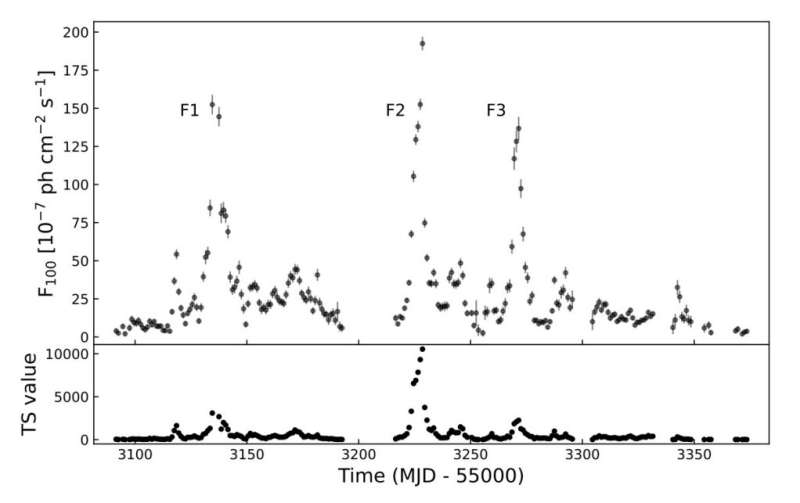January 4, 2023 report
This article has been reviewed according to Science X's editorial process and policies. Editors have highlighted the following attributes while ensuring the content's credibility:
fact-checked
trusted source
proofread
Researchers inspect gamma-ray flares of the blazar 3C 279

Using NASA's Fermi spacecraft, Chinese astronomers have investigated the variability and spectral behavior of gamma-ray flares in a distant blazar known as 3C 279. Results of the study, presented in a paper published in the Publications of the Astronomical Society of the Pacific, could help researchers better understand the flaring activity of blazars.
Blazars are very compact quasars associated with supermassive black holes at the centers of active, giant elliptical galaxies. Based on their optical emission properties, astronomers divide blazars into two classes: flat-spectrum radio quasars (FSRQs) that feature prominent and broad optical emission lines, and BL Lacertae objects (BL Lacs), which do not.
At a distance of about 5 billion light years, 3C 279 is an FSRQ with an estimated black hole mass of 300–800 million solar masses. It is a bright and powerful gamma-ray source in the high-energy sky and is known as the first blazar showing strong and rapid variability at GeV energies.
In the past 10 years 3C 279 experienced several outbursts, and three of them, in the gamma-ray regime, occurred in 2018. A team of astronomers led by Gege Wang of the Guangzhou University in China, observed these three gamma-ray flares using Fermi's Large Area Telescope (LAT).
"In this paper, we analyze the LAT data and investigate the rapid variability and spectral behaviors of quasar 3C 279 during the three gamma-ray flares in 2018. In the obtained daily binned long-term LAT light curve, we pronounced three gamma-ray flares (F1, F2, F3) during MJD 58091 to MJD 58373 in the energy range of 0.1–300 GeV," the researchers wrote.
Wang's team managed to make only a detailed minute timescale binned light curve and a gamma-ray spectral analysis for the flare F2 as the flares F1 and F3 did not show noteworthy fast components or profiles. It turned out that the gamma-ray flux peak in F2 has exceeded the level that was recorded during previous flaring activity in 2015.
The study found that the gamma-ray spectra of 3C 279 in either the flaring or quiescent states do not show any clear breaks. The finding suggests that the blazar's gamma-ray dissipation region is outside the broad-line region (BLR) and the energy dissipation may be due to the inverse Compton (IC) process of scattering the dusty torus infrared photons.
The astronomers calculated the broadband spectral energy distribution (SED) for "pre-outburst," "flare" and "post-flare" states of the flare F2. They also calculated the blazar's magnetization ratio and the electron to magnetic field energy density ratio. All in all, the results indicate that the flare F2 was possibly caused by an injection of higher-energy electrons from outside of the dissipation blob.
"We suggest an injection of higher-energy electrons from outside the blob and raising the flare.... Electrons are accelerated to higher energy outside and injected into the blob in a very short time," the authors of the paper concluded.
More information: Gege Wang et al, Variability and Spectral Behavior of Gamma-Ray Flares of 3C 279, Publications of the Astronomical Society of the Pacific (2022). DOI: 10.1088/1538-3873/ac98e0. On arXiv: arxiv.org/abs/2212.13395
© 2023 Science X Network





















